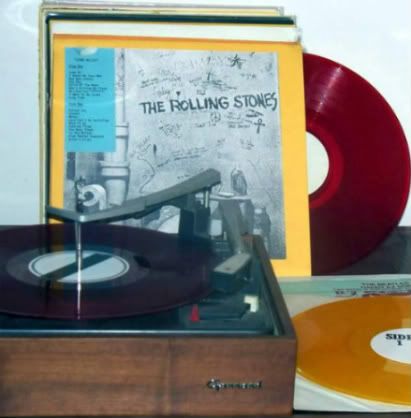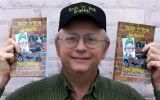
Bootleg records, popular in the 1970s,
featured such acts at The Rolling Stones,
Bob Dylan and The Beatles.
By STEVE SEYMOUR
Unofficial recordings, such as live tracks, studio out-takes or demo tapes, fulfilled a need among collectors beginning in the 1970s.
Known as "bootlegs," these recordings usually offered material not included on an artist's long-playing record albums.
Not sanctioned by the record companies or the musicians themselves, bootlegs were sold on the underground or black market. They shouldn't be confused with "counterfeits" which are illegal reproductions of conventional albums.
I distinctly remember buying two early bootlegs featuring songs by The Beatles and Bob Dylan, probably the most popular rock acts of the era.
My first purchase came from reading the Los Angeles Free Press, a counter-culture weekly, which I bought during a visit to Michigan State University in East Lansing in early 1970. Glancing through one issue, I noticed a classified ad offering a new Beatles album not found in department store bins or other retail outlets.
Intrigued, and maybe a little skeptical, I mailed off my money. At the time, I owned many records by the Fab Four, most released by Capital Records, and new titles were issued at regular intervals. Still, I was looking for something more.
The LP I received from California was issued by a suspicious-sounding Immaculate Conception Records. The 11-track album contained "Christmas Message," recorded by the Beatles exclusively for their Fan Club; a brief number sung by Paul McCartney called "The Walk;" John Lennon's then-current single, "Instant Karma;" "Teddy Boy," which would appear in a re-recorded version on McCartney's first solo album; "You Know My Name (Look Up the Number), a 45 B-side; and "Don't Let Me Down," the flip-side of another single. The remaining six cuts would also appear on the Beatles' LP "Let It Be," released in May, 1970.
The bootleg disc was among the earliest to mine the fertile field of unreleased Beatles' recordings. The bulk of the album apparently originated from an acetate which circulated among various Los Angeles radio stations after recording engineer Glyn Johns assembled an album from tapes the Beatles recorded in January, 1969. The British rock band didn't like the proposed album, however, and shelved it for more than a year. In the interim period they recorded and released the "Abbey Road" album. Finally, the Beatles hired legendary producer Phil Spector to complete the project which he did by adding orchestration and background vocals to some of the tracks.
While I bought plenty of "underground" Beatles albums in the succeeding years, the proliferation of bootlegs actually started with iconic American folk singer Bob Dylan. Born in Minnesota, Dylan gained the attention of his generation by writing and performing such folk-rock hits as "Like a Rolling Stone," "Rainy Day Women #12 & 35" and "Lay Lady Lay."
Two enterprising Los Angeles hippies launched the bootleg business in 1969 by marketing "Great White Wonder," actually 26 Dylan tracks never issued by his record company, Columbia Records.
I didn't run across the record until three years later when I was a student at Central Michigan University in Mount Pleasant. Bulletin boards on campus posted signs about activities, jobs and transportation. But they also contained lists of records students had for sale. Record albums were almost like currency. If you had LPs in good condition by desirable acts of the day, you could sell them quickly for perhaps $2 or $3 each.
It was on one such list that I saw the Dylan album for $5, as I recall. The package consisted of two records in a plain-white cardboard sleeve with the title stamped on the front. The record labels were blank. While the packaging was minimal, it was the music which counted, after all.
Dylan performs with The Band on nine of the album's cuts in what became known as the "basement tapes," which were recorded in the cellar of the singer's Woodstock, New York home.
Most of the remaining tracks were recorded in a Minneapolis hotel room on Dec. 22, 1961, before Dylan signed to Columbia Records. These early recordings feature Dylan alone. "Living the Blues," meanwhile, was taped off network television when Dylan appeared on the Johnny Cash Show on May 1, 1969.
Some of the Dylan material appealed to me, but I wasn't really into folk-rock at that time. Eventually, when I was short on cash, I sold "Great White Wonder" and got my $5 back.
Although I purchased mostly legitimate records, I continued to invest in the occasional bootleg, especially when something interesting came along.
One of the most widely-known bootleg labels,
Trademark of Quality, used this swine-inspired
artwork as a logo.
One particularly prolific bootleg label I patronized was called Trademark of Quality (TMQ). Their unusual logo featured the drawing of a hog with the label's name circling it. The records were inserted into white jackets along with a photo-copied sheet of paper with the title, song selection, and perhaps a picture or two. The idea was that upon taking the record home, the customer could glue the cover on.
The TMQ records were pressed on red, blue, or yellow vinyl, adding some color to the package.
TMQ issued material by the most popular acts of the day, including The Beatles, Rolling Stones, Pink Floyd, Jimi Hendrix, Grateful Dead and Frank Zappa.
I bought one by the Rolling Stones titled, "Stone Relics," comprising 20 of the group's early songs, including "Come On," "I Wanna Be Your Man," and "High Heeled Sneakers." The do-it-yourself cover pictured some rather innocent graffiti on a bathroom wall which was rejected by the band's record company as the artwork to their "Beggars Banquet" album in America.
Some of The Beatles' boots I acquired bore the titles "Yellow Matter Custard," "In Atlanta Whiskey Flat" and "Hahst Az Son." Many of the most sought of the Beatles' unreleased recordings were eventually issued on "Live at BBC" and the "Anthology" series.
By the mid-1980s, bootlegs started to appear in the compact disc format. While it had been easy to bootleg LPs due to the country's many pressing plants, there were few CD facilities and they were busy manufacturing legitimate product. It wasn't long, however, before CD plants around the world were pressing high quality bootlegs which often looked like official product.
My wife Sue and I were into the Grateful Dead by this time and we decided to collect every bootleg we could find. We bought dozens of titles from the United States, Italy, Luxembourg and elsewhere. An incredible amount of material was available because the Grateful Dead allowed fans to record their concerts and encouraged tape trading. Since they played thousands of shows, there was an abundance of material available. Bootlegs ran in quality from poor to professional sounding.
But after collecting Grateful Dead bootlegs for a few years, it became impossible to keep up with the flow of new titles. When the band decided to officially release many of their shows in several series, including "Dick's Picks" and "From the Vault," we decided to sell our bootleg collection.
During this period, terminology changed and bootlegs were often called "imports," making them seem more legitimate.
Singer/songwriter and rock satirist Frank Zappa, founder of the Mothers of Invention, beat the bootleggers at their own game in 1991 when he collected many of the best bootlegs of his material and re-released them as "Beat the Boots." With the turnaround, Zappa made the profit from his recordings rather than the bootleggers getting it. A second box appeared in 1992.
Today, computer technology has sent the bootleg into the history books. It seems few people want to buy a bootleg when the material is downloadable on the Internet for free.
Appealing to collectors at an earlier time, the bootleg has become an anachronism.


 I've enjoyed rock music and writing since I was a teenager in the 60s. I feel lucky to have been around when rock's greatest stars created their most enduring hits. At the same time I found I enjoyed writing, as well. I worked on my high school newspaper and magazine, was editor of several college publications and earned a bachelor's degree from Central Michigan University in 1973. I worked for the daily newspaper in my hometown after graduating, becoming managing editor after a few years. By the 1980s, I moved into public relations. In 1985, my wife Sue and I opened a retail music store, The Record Rack, which we still own. Rock 'n' roll has been integral to me and for the last 2O years I've been earning my living from it even though I don't have a musical bone in my body. In recent years, I've also I edited a small local magazine and launched a micro FM radio station. Now, I'm finally combining my love of writing and rock 'n' roll. I can't sing a note, but I know what I like. I'll tell you all about it when you read on. I hope you have as much enjoyment reading these installments as I've had writing them.
I've enjoyed rock music and writing since I was a teenager in the 60s. I feel lucky to have been around when rock's greatest stars created their most enduring hits. At the same time I found I enjoyed writing, as well. I worked on my high school newspaper and magazine, was editor of several college publications and earned a bachelor's degree from Central Michigan University in 1973. I worked for the daily newspaper in my hometown after graduating, becoming managing editor after a few years. By the 1980s, I moved into public relations. In 1985, my wife Sue and I opened a retail music store, The Record Rack, which we still own. Rock 'n' roll has been integral to me and for the last 2O years I've been earning my living from it even though I don't have a musical bone in my body. In recent years, I've also I edited a small local magazine and launched a micro FM radio station. Now, I'm finally combining my love of writing and rock 'n' roll. I can't sing a note, but I know what I like. I'll tell you all about it when you read on. I hope you have as much enjoyment reading these installments as I've had writing them.


No comments:
Post a Comment